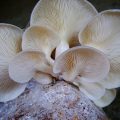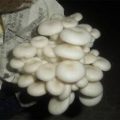The Department of Agriculture (DA) is putting up an P8 million Mushroom Technology Center (MTC) in Tarlac to boost mushroom production and substitute imports from Taiwan while generating P300 per kilo income to farmers.

The mushroom center will enable manufacturing of value-added processed foods including mushroom tocino and longganiza and mushroom meals like siomai, burger, bola bola and sisig. Bidding process for the project is on-going.
DA Sec. Proceso J. Alcala is allotting P3 million for the MTC, while Bureau of Agricultural Research (BAR) is funding the bulk of the project at P5 million.
There are other highly prospective processed goods for mushrooms, according to DA-Regional Field Unit 3 Project Leader Emily A. Soriano.
These are pickled mushroom, mushroom jam, mushroom candies, crackers, cookies, polvoron, wine, pandesal with malunggay, barquillos, muffins, and powder.
“We import 90 percent of our mushrooms. But we want Central Luzon including Tarlac to be known as a major producer of mushroom. This can generate income of P180 per kilo at farmgate and P300 per kilo at retail. When processed, they can give higher additional income to our farmers,” said Soriano.
DA is also targeting Overseas Filipino Workers (OFW) to become beneficiaries of the mushroom center, according to BAR Director Nicomedes P. Eleazar.
“Secretary Alcala wants our OFWs in Hongkong and Singapore to get oriented on business opportunities when they go back to the country. So we decided we should improve our facilities since this is a good employment program for them,” said Eleazar.
Through processing, shelf life of mushroom fruits last to 14 months, depending on packaging and storage.
Without processing, farmers suffer from spoilage since fresh mushrooms can just last in three days as its substantial water content causes fast staleness. Profitability also increases by 30 to 70 percent when fresh mushrooms are turned into value added products.
“The estimated value-added income for producers range from P40 to P239 per kilo of mushroom fruits,” according to a DA-Central Luzon Integrated Agricultural Research Center (CLIARC) report.
The country is estimated to import around 150 metric tons (MT) of mushrooms yearly largely from South East Asia—Taiwan, China, Thailand, and Japan.
At the prevailing retail price of P300 per kilo, farmers can earn some P45 million yearly just by substituting imports.
Mushroom cooperative
Soriano said RFU3 has already helped establish the Mushroom Producers Cooperative in Anao, Tarlac. Just organized last February, it now has 23 members. From their mushroom production, each member is presently receiving P700 to P3,500 per month from the cooperative.
The cooperative is producing less than 10 kilos per day. DA-CLIARC aims to raise this volume depending on demand of mushroom in the market.
Even before the technology center’s completion, DA has already been receiving inquiries from interested entrepreneurs on the mushroom products.
“Many private individuals have been inquiring from us. But we’re still on the product development stage. We’re also sending our products for nutrition analysis through our partners at BAR,” she said.
Nutrient-rich
Mushroom goods are ideal food supplement products since mushrooms can retain their vitamins and minerals even after various processing methods, according to Soriano.
Known mostly for its rich protein, mushrooms also have Vitamin D, B1 (Thiamin), B2 (Riboflavin), B3 (Pantothenic Acid), B9 (Folate), and H (Biotin). Minerals contained are sodium, potassium, calcium, iron, zinc, magnesium, selenium, and ergothioneine.
RFU3 is also collaborating with the chemical laboratory of the Philippine Rice Research Institute (Philrice) as well as the Department of Science on Technology on the same effort on nutrient analysis for mushroom products. The Department of Trade and Industry is also extending assistance in product label design.
Most mushrooms can be grown in the Philippines. DA is also engaged in tissue culture of mushroom which can maximize mushroom seed production in order to meet demand.
DA is continuously developing technologies in raising yield of mushroom.
Materials for growing mushroom are readily available in the environment and are usually considered waste, making growing mushrooms a profitable venture. It is grown on materials like rice straw, sugarcane bagasse, tobacco midribs, water lilies, sawdust, corn cobs, corn leaves, grass, banana bark, and similar materials.
Mushroom grows over 1.5 months from spawn production (mushroom seed) to harvest.
For tissue culture, DA can also train more technicians in its four stages. These are pure culture fresh mushroom; rapid multiplication (subcultures); spawn preparation; and planting for fruit production.
Food safety
In order to ensure food safety, CLIARC is likewise promoting sanitation and safety processes under its own study “Sanitation and Hygiene in the Production of Mushroom Food Products.”
Food hazards associated with mushroom production are biological including bacteria, yeast, molds, viruses, insects, and parasites; chemical—pesticides and toxic elements; and physical—plastic, wood chips, paper, hair, and sand.
However, harmful microorganisms are among the most critical hazards being commonly found in nature.
Good Manufacturing Practice (GMP) is a manufacturing practice strictly observed in developed countries like the United States particularly mandated in the pharmaceutical and medical industries. GMP should be put in place.
The technology center will have a laboratory for mushroom tissue culture, a gene bank that will keep mushroom species for research on their traits and study of commercial potential; and a product display area.
Central Luzon
Central Luzon provinces—Tarlac, Pampanga, Bulacan, Zambales, Nueva Ecija, Bataan, and Aurora—have the potential to become big mushroom producers.
The technology center can reach out to farmers and entrepreneurs for product development and training in these provinces.
“Monthly Income of assisted farmer beneficiaries will have increased by 50 percent as of November 2013,” said Soriano.
In the MTC, the local government units in Tarlac—the towns of Anao, Camiling, and Victoria—are partners in developing and commercializing new mushroom products.
Soriano is concerned that not many state universities and colleges and government support institutions are engaged in product development for mushroom. This is one of the problems she identified in her masteral study “State of Mushroom Industry in Central Luzon.”
“We’re developing products for different segments of the market,” she said. “We’re also looking at products for public schools.”
DA is specifically using mushroom genus called pleurotus and volvariella which grow well under Philippine environment.
Product testing
The BAR-funded project has so far trained around 400 participants for mushroom processing in Regions 1, 2, 3, 4, and 5, while technical assistance was given to four communities in order to set up mushroom production and processing for livelihood.
In order to capture high-end markets, product testing is being conducted particularly on sensory evaluation (taste and appearance). A Food and Drug Administration registration will be obtained to ensure food safety, consequently better marketing of the products in supermarkets.
Innovative goods
Industrial scale processing can also be achieved with new product lines such as seasoning, nuggets, noodles and mixture for soup. The project has tapped certified food technologies for these innovative products.
“Elemental analysis as well as microbial load for food safety will also be tested for finished products,” said Soriano.
For new farmers’ and entrepreneurial organizations, the project will assist groups in cooperative formation, business registration, organizational policy formulation, business plan preparation, basic financial management training, marketing strategies, values formation, and conflict resolution.
==
For any questions, please call Dr. Emily Soriano, 0916-279-1956; for interview requests, Ms. Analiza C. Mendoza, 0923-436-3177







With the 10 prospect mushrooms that could be cultivated in the Philippines, what species are now being grown in the MTC?
10 prospect mushroom species:
Paddy straw mushroom
Oyster mushroom
Shiitake mushroom
Button mushroom
Ear fungi mushroom
Milky mushroom
Yellowish oyster mushroom
Reishi mushroom
Lion`s mane mushroom
King tuber oyster mushroom.
Hello. May I have the references of this report. It would help me a lot. Thank you.
kung magbibusiness po ako ng oyster mushroom saan po pwede ideliver ang producto,,nais kopo sanang magnegosyo sana po meron din pong pwedeng bagsakan ng aking maaani salamat po..